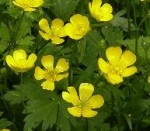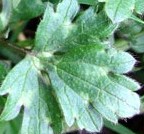 Creeping buttercup is a perennial weed native to Europe, Asia and northwestern Africa but is now found in most of the United States. The bright yellow flowers make it attractive enough to have been an ornamental plant is some places and the cultivar “Buttered Popcorn” is still considered a versatile ground cover worthy of notice. The plant thrives in sun to part shade on wet, poorly drained soil and can be found in wetlands, pastures, gardens, and lawns as well as beaches, tidal estuaries and salt marshes due to its salt tolerance. Although it is toxic to most grazing animals, its bitter taste causes the animals to avoid it.
Creeping buttercup is a perennial weed native to Europe, Asia and northwestern Africa but is now found in most of the United States. The bright yellow flowers make it attractive enough to have been an ornamental plant is some places and the cultivar “Buttered Popcorn” is still considered a versatile ground cover worthy of notice. The plant thrives in sun to part shade on wet, poorly drained soil and can be found in wetlands, pastures, gardens, and lawns as well as beaches, tidal estuaries and salt marshes due to its salt tolerance. Although it is toxic to most grazing animals, its bitter taste causes the animals to avoid it.

 Description: Creeping buttercup forms a low-growing mat due to stolons that root at the nodes and one plant can cover a 40 foot area in a year. Although the stems can be up to 12” tall, creeping buttercup withstands mowing and trampling so is often much shorter. The dark green hairy leaves have white patches and are deeply divided into three toothed lobes. Basal leaves are carried on long petioles while ascending leaves have shorter ones. Flowers appear singly on long stems from early spring into summer and have 5 or 10 bright yellow waxy petals. Globe-shaped seed heads consist of clusters of 20-50 one-seeded fruits (achenes), each achene bearing a hooked beak that is important in seed dissemination. The seeds can remain viable in the soil for 20-80 years. The root system consists of slender, fibrous roots.
Description: Creeping buttercup forms a low-growing mat due to stolons that root at the nodes and one plant can cover a 40 foot area in a year. Although the stems can be up to 12” tall, creeping buttercup withstands mowing and trampling so is often much shorter. The dark green hairy leaves have white patches and are deeply divided into three toothed lobes. Basal leaves are carried on long petioles while ascending leaves have shorter ones. Flowers appear singly on long stems from early spring into summer and have 5 or 10 bright yellow waxy petals. Globe-shaped seed heads consist of clusters of 20-50 one-seeded fruits (achenes), each achene bearing a hooked beak that is important in seed dissemination. The seeds can remain viable in the soil for 20-80 years. The root system consists of slender, fibrous roots.

 Control: Creeping buttercup should be dug out so that no roots are left behind since root fragments can produce new plants. This is best done when the soil is moist and the plants are young in order to reduce root breakage. Superficial cultivation increases the weed problem as it encourages seed germination and the growth of root fragments as well as sprouting at the nodes of the stolons. Non selective herbicides such as glyphosate and broadleaf herbicides containing MCPA are effective but will need more than one application.
Control: Creeping buttercup should be dug out so that no roots are left behind since root fragments can produce new plants. This is best done when the soil is moist and the plants are young in order to reduce root breakage. Superficial cultivation increases the weed problem as it encourages seed germination and the growth of root fragments as well as sprouting at the nodes of the stolons. Non selective herbicides such as glyphosate and broadleaf herbicides containing MCPA are effective but will need more than one application.